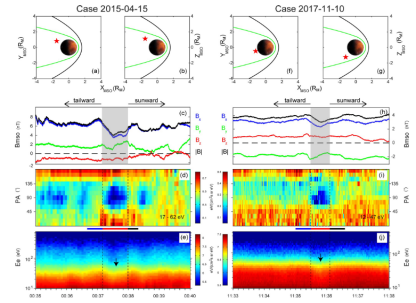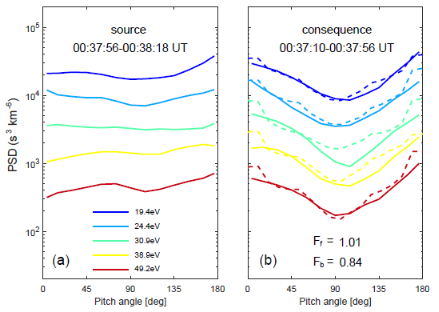Recently, the latest findings by Prof. Fu Huishan’s team from the School of Space and Environment, titled “Betatron Cooling of Electrons in Martian Magnetotail”, were published in Geophysical Research Letters, a prestigious journal in the field of space physics. The results, for the first time demonstrating the betatron-cooling effect beyond the Earth, are useful to understand the electron dynamics in the planetary magnetosphere.
Among the eight planets in the solar system, Mars is the most-studied terrestrial planet. The exploration and research of Mars plays an irreplaceable role in understanding the earth. Mars has no intrinsic magnetotail and the Martian magnetotail is formed due to the wrap of Martian ionosphere by the interplanetary magnetic field (IMF). As a result, the Martian magnetotail is more dependent on the solar wind and IMF condition, and more active than the Earth's magnetotail. In such an active magnetotail, electron dynamics should be very complicated. So far, the electron betatron cooling had never been reported in the Martian magnetosphere.

Fig. 1 Overview of two events of betatron cooling measured by Mars Atmosphere and Volatile EvolutioN (MAVEN) on April 15, 2015 and November 10, 2017
Observations of electron betatron cooling are shown in Fig.1. Under the condition that the magnetic moment (the first adiabatic invariant) is conserved, the local depression of magnetic fields leads to the drop of electron fluxes in the perpendicular direction. By utilizing data from the Mars Atmosphere and Volatile EvolutioN (MAVEN) mission, Prof. Fu Huishan’s team discovered such betatron-cooling process in Martian Magnetotail for the first time. After a detailed analysis of the electron distribution function, they found that such betatron-cooling process can happen in the thermal-energy, suprathermal and energetic ranges. Meanwhile, they built a physical model to reproduce such betatron-cooling process quantitatively, and found that the cooling factor derived from the analytical model agrees well with the MAVEN observations of magnetic depression (Fig. 2). Thus, they quantitatively confirmed the betatron cooling process of electrons in Martian magnetotail.

Fig. 2 Quantitative comparison of observed data (solid lines) and model calculations (dashed lines)
With the continuous progress of China's aviation and space industry, our space science, technology and application have also been comprehensively developed. In recent years, the team led by Professor Cao Jinbin from the School of Space and Environment has conducted scientific research on the moon and Mars for deep space exploration of China’s space strategy, using the lunar exploration data from China's Chang'E series satellites and the Mars exploration data from Tianwen-1, and has achieved some important results.
Founded in 1974, Geophysical Research Letters is a well-known journal of geoscience published by the American Geophysical Union. It mainly publishes the latest research results in the fields of space physics, solid Earth, atmospheric sciences, climatology, oceanography, hydrology, land surface processes and the cryosphere.
The research was supported by the National Natural Science Foundation of China.
Link to the article: http://dx.doi.org/10.1029/2021GL093826
Reported by Teng Xiong and Guo Zhizhong
Reviewed by Tang Li
Edited by Jia Aiping
Translated by Liang Xiaochun

